Research on Gas Recycling of Free-Piston Expander–Linear Generator for Organic Rankine Cycle of Vehicle
Abstract
1. Introduction
1.1. Application Status of Organic Rankine Cycle
1.2. Research Status of Free-Piston Expander Linear Generator
2. FPE-LG Test Bench
3. Results and Discussion
3.1. Analysis of the Influence of Gas Tank Volume on the FPE-LG Gas Recycling Process
3.2. Analysis of Influence of Inlet Pressure on FPE-LG Gas Recycling Process
3.3. Analysis of the Influence of Intake Duration on the FPE-LG Gas Recycling Process
3.4. Impact Analysis of Expansion Duration on FPE-LG Gas Recycling Process
3.5. Analysis of Influence of Exhaust Duration on FPE-LG Gas Recycling Process
3.6. Impact Analysis of Electric Energy Storage during FPE-LG Gas Recycling
4. Summary and Conclusions
- The time required for gas storage is lower than the time required for gas release. By increasing the volume of the gas storage tank, the time required for gas storage and release becomes longer. Inlet pressure, inlet duration, expansion duration and exhaust duration all have different effects on the process of gas storage and release. When the volume of the gas storage tank is 50 L and the inlet pressure is 0.5 MPa, gas storage and gas release require 126.962 s and 131.242 s, respectively.
- The actual stroke of the piston during gas storage is smaller than that during gas release. The volume of the gas storage tank and different operating conditions have a significant impact on the actual stroke of the piston during the gas storage process, while the impact on the gas release process is relatively small, the maximum actual stroke of the piston can reach 89.592 mm.
- The peak velocity of the piston during gas storage is lower than that during gas release. The volume and inlet pressure of the gas storage tank have a significant impact on the peak velocity of the piston during storage, but have a smaller impact on the piston velocity during gas release. Increasing the volume and inlet pressure of the gas storage tank increases the peak velocity of the piston accordingly. The intake duration time, expansion duration time and exhaust duration time have little influence on the piston peak velocity.
- The energy storage of lithium batteries increases with the increase of intake pressure, and the energy stored in lithium batteries during gas release is higher than that during gas storage. The intake duration, expansion duration and exhaust duration have little effect on the storage of lithium battery energy during the cycle.
Author Contributions
Funding
Institutional Review Board Statement
Informed Consent Statement
Data Availability Statement
Acknowledgments
Conflicts of Interest
Abbreviations
| Nomenclature | |
| pin | Intake pressure (bar) |
| tin | Intake duration time (ms) |
| texp | Expansion duration time (ms) |
| texh | Exhaust duration time (ms) |
| Acronyms | |
| ORC | Organic Rankine cycle |
| FPE-LG | Free-piston expander–linear generator |
| LG | Linear generator |
| OTDC | Operation top dead center |
| OBDC | Operation bottom dead center |
References
- Feng, Y.; Hung, T.; Greg, K.; Zhang, Y.; Li, B.; Yang, J. Thermoeconomic comparison between pure and mixture working fluids of organic Rankine cycles (ORCs) for low temperature waste heat recovery. Energy Convers. Manag. 2015, 106, 859–872. [Google Scholar] [CrossRef]
- Wang, B.; Yu, X.; Xu, H.; Wu, Q.; Wang, L.; Huang, R.; Li, Z.; Zhou, Q. Scenario analysis, management, and optimization of a new Vehicle-to-Micro-Grid (V2μG) network based on off-grid renewable building energy systems. Appl. Energy 2022, 325, 119873. [Google Scholar] [CrossRef]
- Guo, T.; Wang, H.X.; Zhang, S.J. Fluids and parameters optimization for a novel cogeneration system driven by low-temperature geothermal sources. Energy 2011, 36, 2639–2649. [Google Scholar] [CrossRef]
- Catapano, F.; Frazzica, A.; Freni, A.; Manzan, M.; Micheli, D.; Palomba, V.; Sementa, P.; Vaglieco, B. Development and experimental testing of an integrated prototype based on Stirling, ORC and a latent thermal energy storage system for waste heat recovery in naval application. Appl. Energy 2022, 311, 118673. [Google Scholar] [CrossRef]
- Ramirez, M.; Epelde, M.; de Arteche, M.G.; Panizza, A.; Hammerschmid, A.; Baresi, M.; Monti, N. Performance evaluation of an ORC unit integrated to a waste heat recovery system in a steel mill. Energy Procedia 2017, 129, 535–542. [Google Scholar] [CrossRef]
- Lion, S.; Vlaskos, I.; Rouaud, C.; Taccani, R. Overview of the Activities on Heavy Duty Diesel Engines Waste Heat Recovery with Organic Rankine Cycles (ORC) in the Frame of the ECCO-MATE EU FP7 Project. Energy Procedia 2017, 129, 786–793. [Google Scholar] [CrossRef]
- Champagne, C.; Weiss, L. Performance analysis of a miniature free piston expander for waste heat energy harvesting. Energy Convers. Manag. 2013, 76, 883–892. [Google Scholar] [CrossRef]
- Preetham, B.; Weiss, L. Investigations of a new free piston expander engine cycle. Energy 2016, 106, 535–545. [Google Scholar] [CrossRef]
- Bouvier, J.L.; Lemort, V.; Michaux, G.; Salagnac, P.; Kientz, T. Experimental study of an oil-free steam piston expander for micro-combined heat and power systems. Appl. Energy 2016, 169, 788–798. [Google Scholar] [CrossRef]
- Burugupally, S.P.; Weiss, L. Design and performance of a miniature free piston expander. Energy 2019, 170, 611–618. [Google Scholar] [CrossRef]
- Wang, Y.; Chen, L.; Jia, B.; Roskilly, A.P. Experimental study of the operation characteristics of an air-driven free-piston linear expander. Appl. Energy 2017, 19, 93–99. [Google Scholar] [CrossRef]
- Wu, Z.; Zhang, H.; Liu, Z.; Hou, X.; Li, J.; Yang, F.; Zhang, J. Experimental study on the performance of single-piston free-piston expander—Linear generator. Energy 2021, 221, 119724. [Google Scholar] [CrossRef]
- Wu, Z.; Zhang, H.; Liu, Z.; Tian, G.; Hou, X.; Yang, F. Force and energy analysis of single-piston free-piston expander—Linear generator. Energy 2022, 251, 123926. [Google Scholar] [CrossRef]
- Xu, Y.H.; Tong, L.; Zhang, H.G.; Hou, X.C.; Yang, F.B.; Yu, F.; Yang, Y.X.; Liu, R.; Tian, Y.M.; Zhao, T.L. Experimental and simulation study of a free piston expander–linear generator for small–scale organic Rankine cycle. Energy 2018, 161, 776–791. [Google Scholar] [CrossRef]
- Gusev, S.; Ziviani, D.; Vierendeels, J.; De Paepe, M. Variable volume ratio free-piston expander: Prototyping and experimental campaign. Int. J. Refrig. 2019, 98, 70–79. [Google Scholar] [CrossRef]
- Tian, Y.; Zhang, H.; Li, G.; Hou, X.; Yu, F.; Yang, F.; Yang, Y.; Liu, Y. Experimental study on free piston linear generator (FPLG) used for waste heat recovery of vehicle engine. Appl. Therm. Eng. 2017, 127, 184–193. [Google Scholar] [CrossRef]
- Tian, Y.; Zhang, H.; Li, J.; Hou, X.; Zhao, T.; Yang, F.; Xu, Y.; Wang, X. Development and validation of a single-piston free piston expander-linear generator for a small-scale organic Rankine cycle. Energy 2018, 161, 809–820. [Google Scholar] [CrossRef]
- Li, G.; Zhang, H.; Yang, F.; Song, S.; Chang, Y.; Yu, F.; Wangle, J.; Yao, B. Preliminary Development of a Free Piston Expander–Linear Generator for Small-Scale Organic Rankine Cycle (ORC) Waste Heat Recovery System. Energies 2016, 9, 300–318. [Google Scholar] [CrossRef]
- Xu, Y.H.; Tong, L.; Zhang, H.G.; Hou, X.C.; Yang, F.B.; Yu, F.; Li, J.X.; Li, J.; Zhao, T.L.; Zhang, M.R. Experimental investigation of a free piston expander-linear generator with different valve timings. Appl. Therm. Eng. 2018, 142, 555–565. [Google Scholar] [CrossRef]
- Xu, Y.; Xue, X.; Wang, Y.; Ai, M. Performance characteristics of compressed air-driven free-piston linear generator (FPLG) system–A simulation study. Appl. Therm. Eng. 2019, 160, 114013. [Google Scholar] [CrossRef]
- Gao, J.; Ma, C.; Tian, G.; Xing, S.; Jenner, P. Numerical investigations of an opposed rotary piston expander for the purpose of the applications to a small-scale Rankine cycle. Appl. Therm. Eng. 2021, 182, 116157. [Google Scholar] [CrossRef]
- Burugupally, S.P.; Weiss, L.; Depcik, C. The effect of working fluid properties on the performance of a miniature free piston expander for waste heat harvesting. Appl. Therm. Eng. 2019, 151, 431–438. [Google Scholar] [CrossRef]
- Aziz, A.R.A.; Ismael, M.A.; Mohammed, S.E.; Baharom, M.B.; Anwarudin, A.R.T. Effect of generator configuration on the free-piston motion and power generation of air-driven expander system. Alex. Eng. J. 2022, 61, 3093–3104. [Google Scholar] [CrossRef]
- Ismael, M.A.; Aziz, A.R.A.; Mohammed, S.E.; Ayandotun, W.B.; Baharom, M.B.; Sallehudin, M.S.; Syakirin, M.; Anwerudin, A.R.T.; Masri, M.M. Investigation on free-piston motion and power generation of a dual-piston air-driven expander linear generator. Energy Rep. 2021, 7, 2388–2397. [Google Scholar] [CrossRef]
- Guo, C.; Zuo, Z.; Jia, B.; Zhang, Z.; Feng, H.; Roskilly, A. Parametric analysis of a dual-piston type free-piston gasoline engine linear generator. Energy Procedia 2019, 158, 1431–1436. [Google Scholar] [CrossRef]
- Song, Y.; Feng, H.; Zuo, Z.; Wang, M.; Guo, C. Comparison Research on Different Injection Control Strategy of CI Free Piston Linear Generator in One-time Starting Process. Energy Procedia 2014, 61, 1597–1601. [Google Scholar] [CrossRef][Green Version]
- Shi, X.; Hou, X.; Yang, F.; Zhang, H.; Shi, Z.; Zhao, T.; Guan, X.; Wu, Y.; Zhang, J. Analysis on operation characteristic and output performance of free piston ex-pander-linear generator based on displacement control strategy. Appl. Therm. Eng. 2021, 182, 116146. [Google Scholar] [CrossRef]

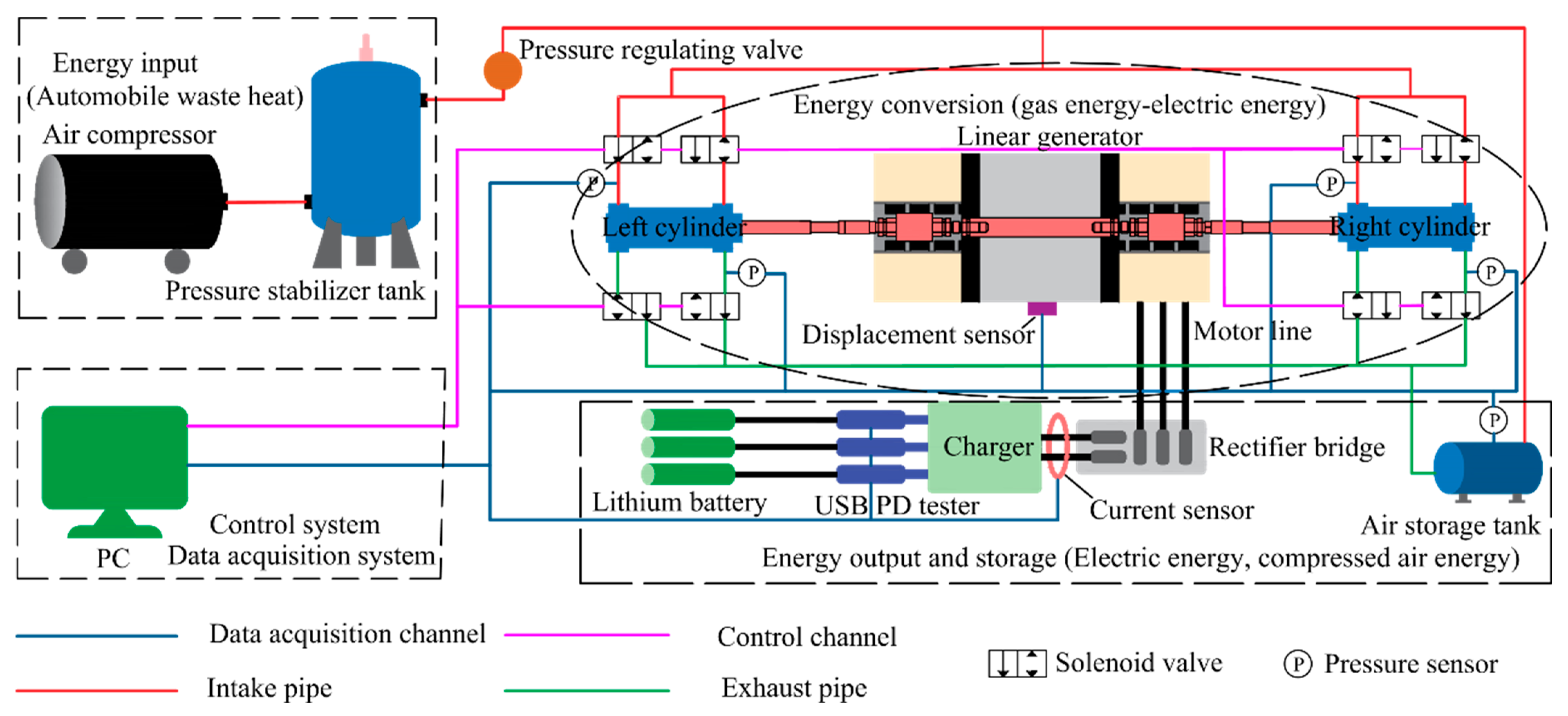
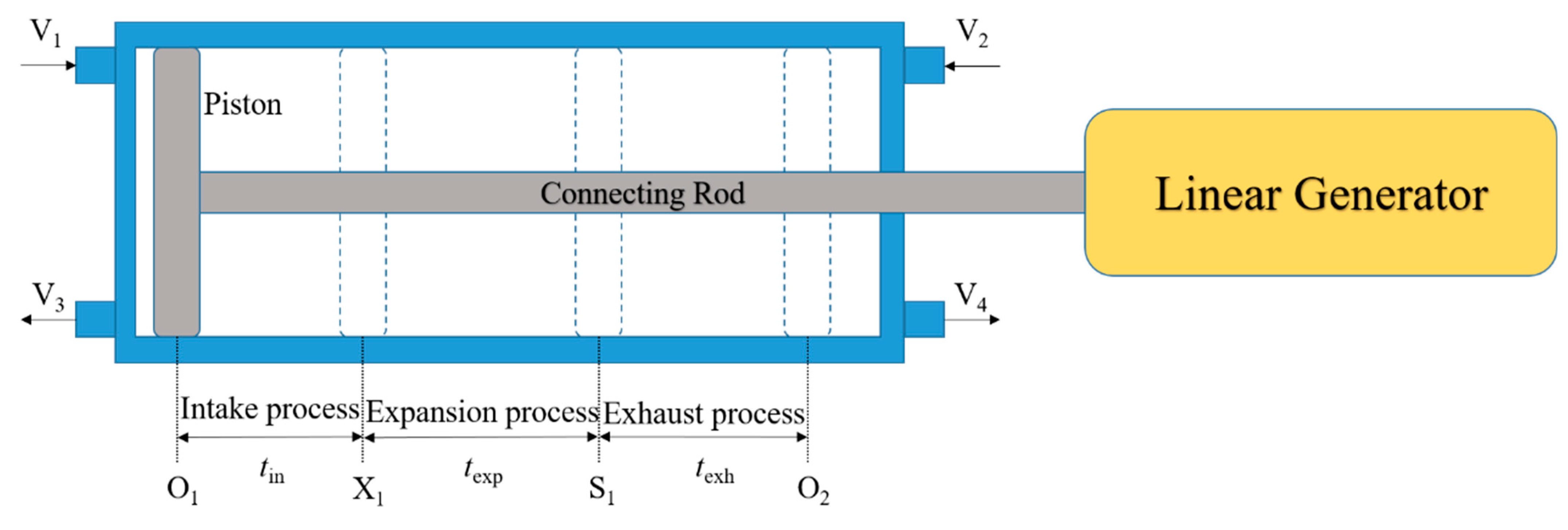
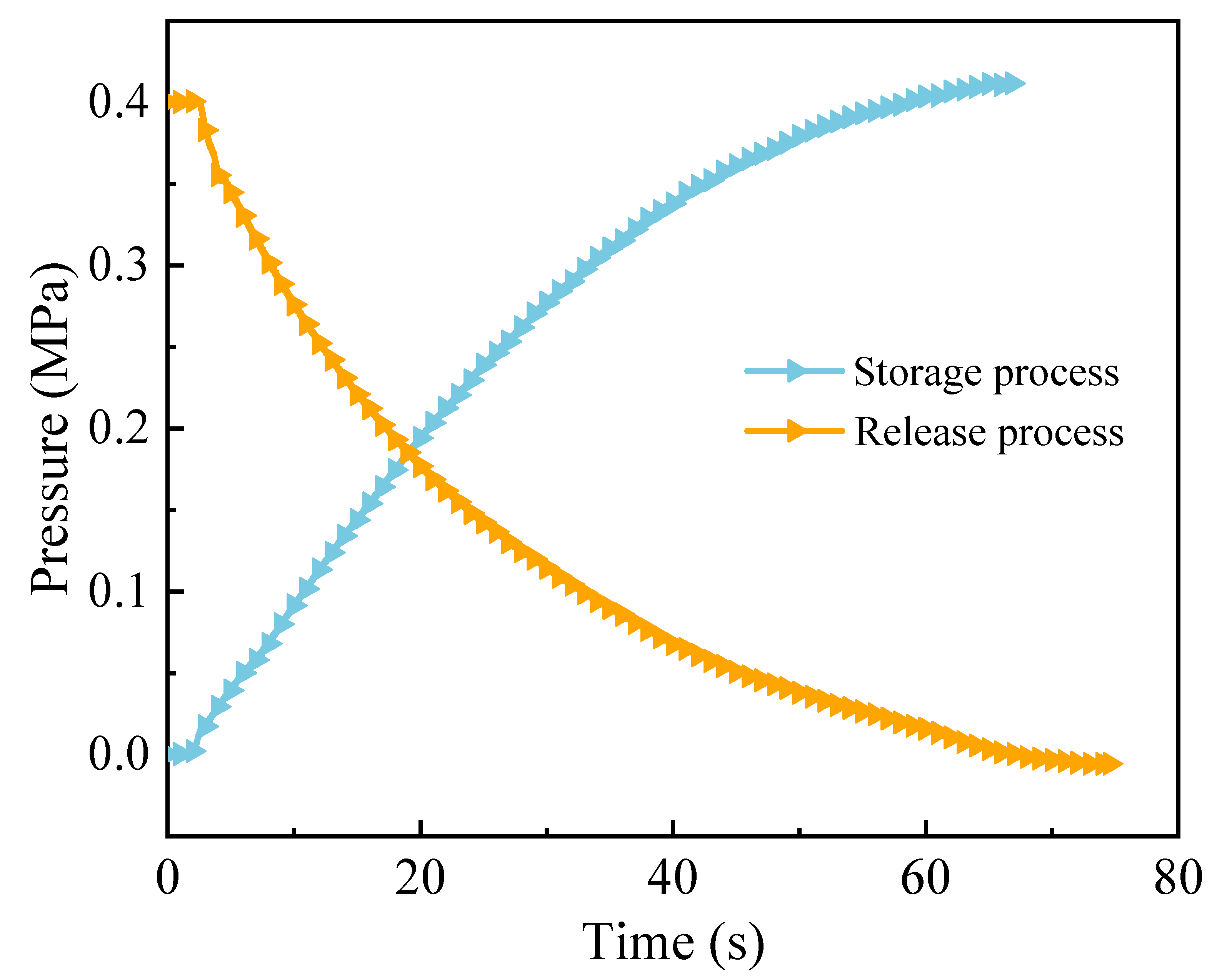





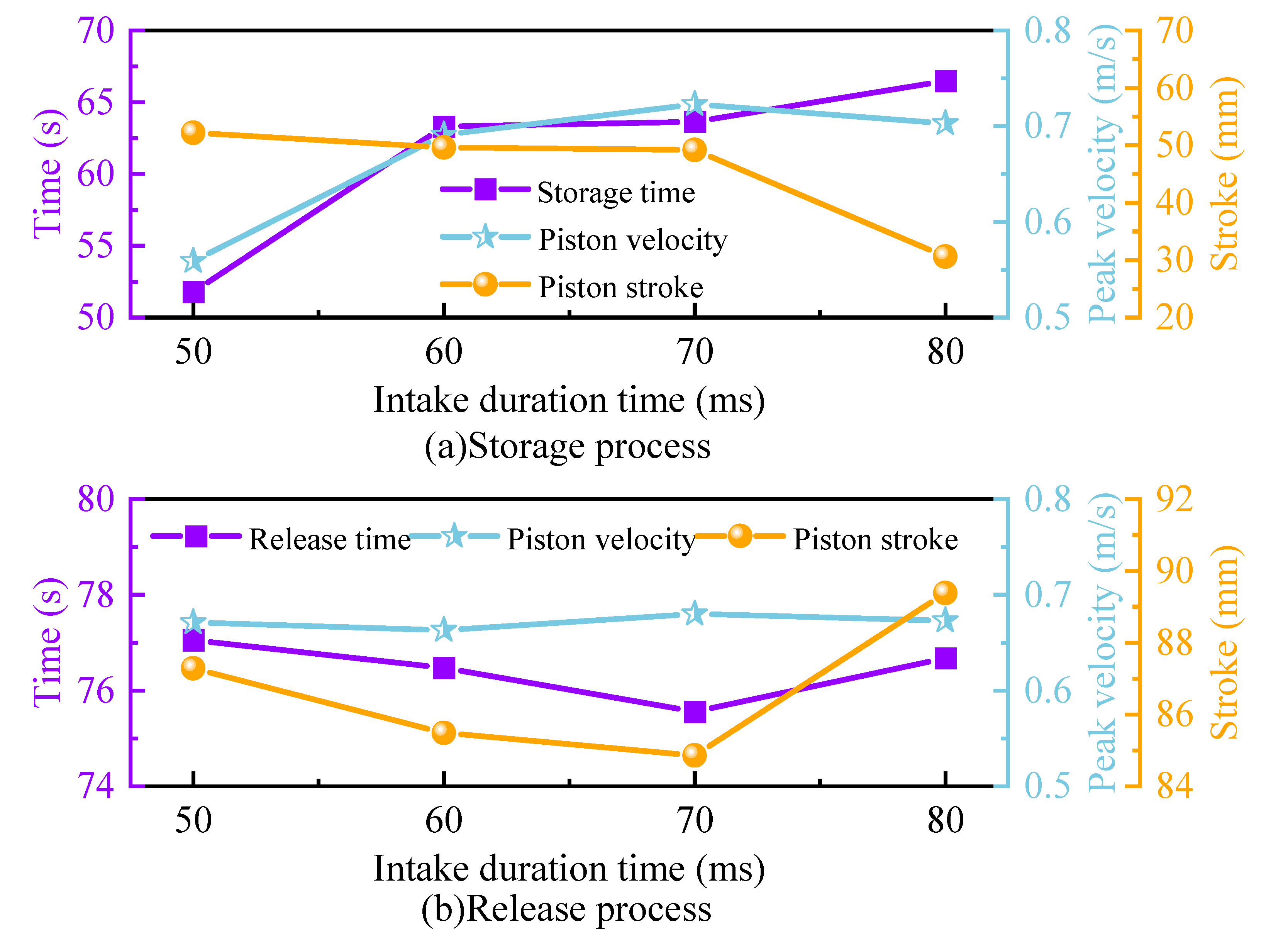
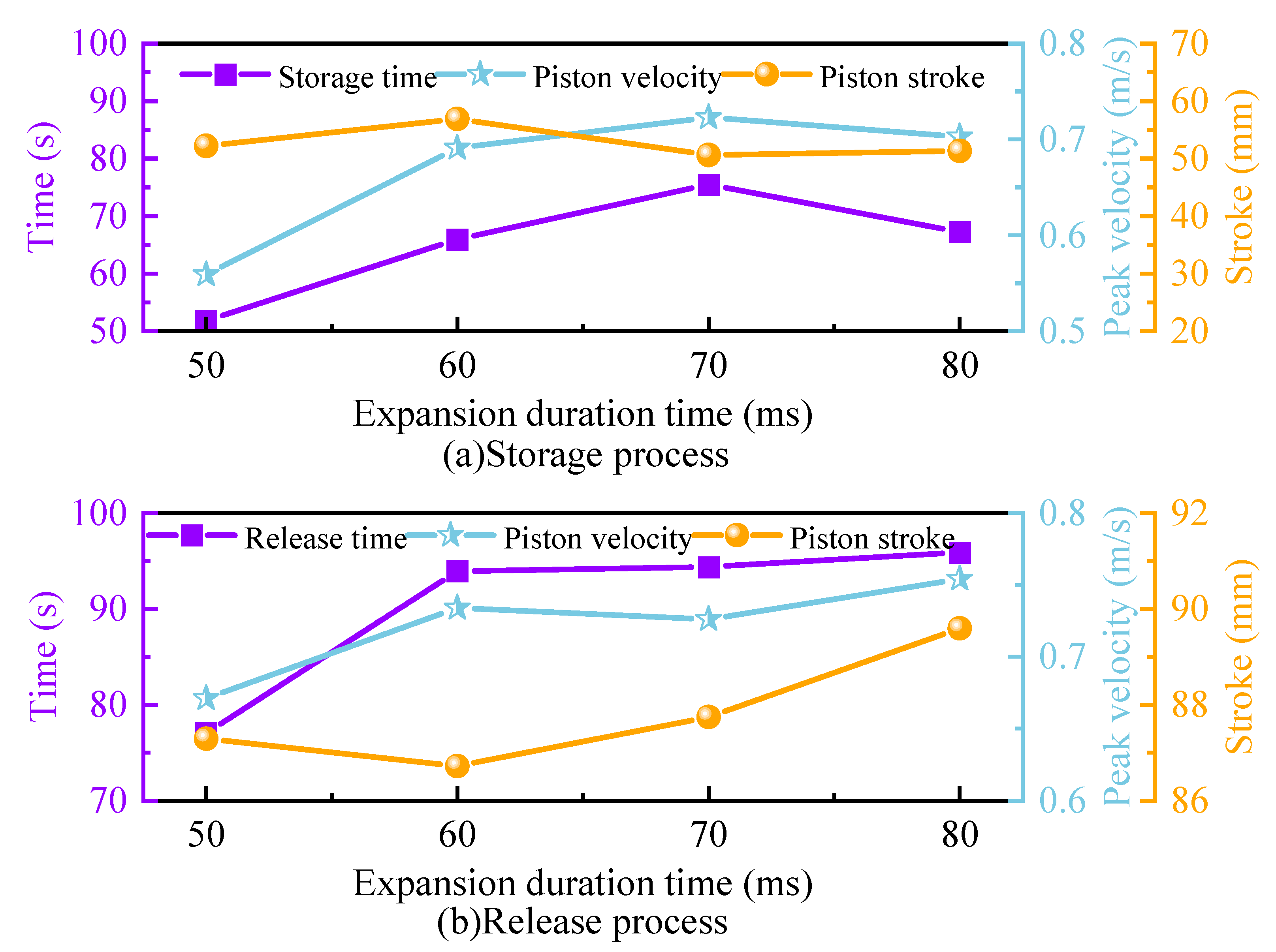
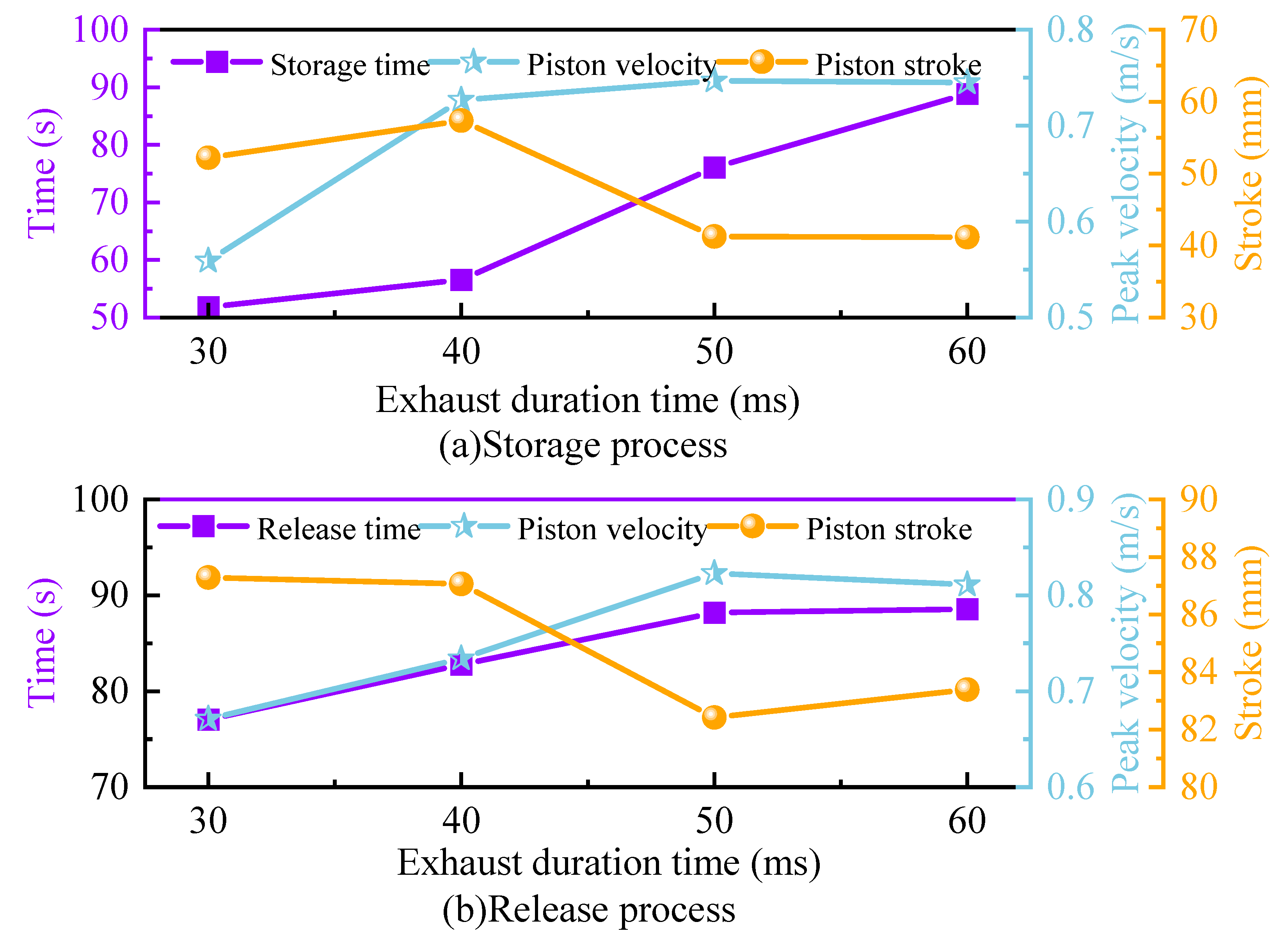
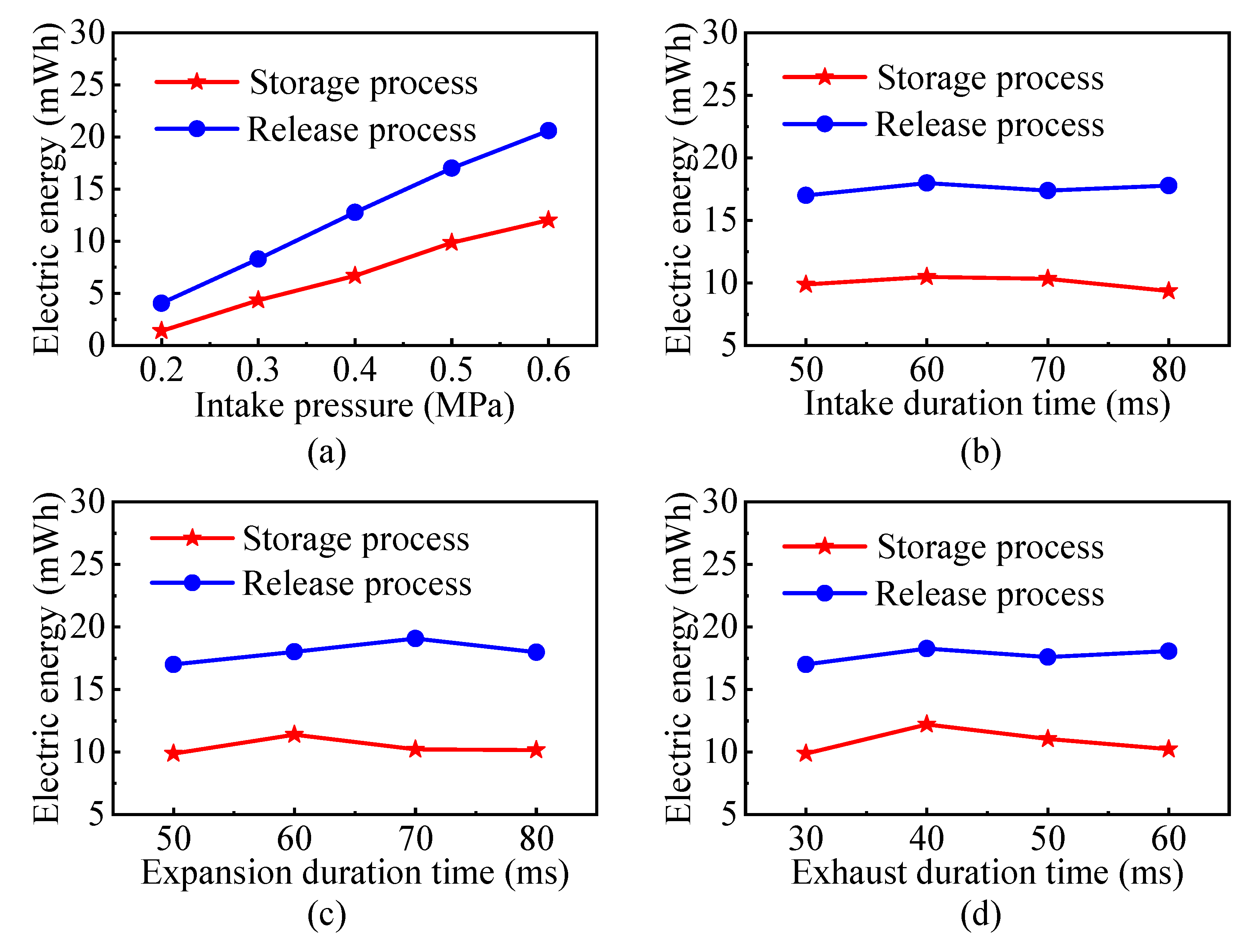
| Items | Main Parameters |
|---|---|
| Cylinder | Diameter 63 mm, stroke: 100 mm |
| Temperature sensor | Range: 0–150 °C, accuracy: 0.5% FS |
| Pressure sensor | Range: 0–10 bar, accuracy: 0.5% FS |
| Driving motor | Rated voltage 48 V, maximum speed: 7590 rpm, rated current 3.17 A, rated torque: 0.187 N·m |
| Solenoid valve | Range: 0–10 bar |
| Dynamic torque sensor | Range: 0–0.5 N·m, accuracy: 0.5% FS |
| Magnetic Powder Brake | Torque: 0–0.5 N·m, power: 8.4 W |
| Tension controller | Output: DC 0–274 V, maximum current: 3 A |
| Three-phase rectifier | Rectification range: 0–30 A |
| Magnetic grid displacement sensor | Image resolution: 0.5 μm |
| Linear generator | Continuous thrust 144 N, peak thrust: 576 N; Pole pitch: 30 mm, Back EMF constant: 20.9 V/(m·s−1), |
| Continuous current 2.3 A, peak current: 9.2 A |
| Electromagnetic Valve Status | Duration | |
|---|---|---|
| Intake process | opened V1, V4; closed V2, V3 | tin |
| Expansion process | closed V1, V2, V3, V4 | texp |
| Exhaust process | opened V4; closed V1, V2, V3 | texh |
| Intake process | opened V2, V3; closed V1, V4 | tin |
| Expansion process | closed V1, V2; V3, V4 | texp |
| Exhaust process | opened V3; closed V1, V2, V4 | texh |
Disclaimer/Publisher’s Note: The statements, opinions and data contained in all publications are solely those of the individual author(s) and contributor(s) and not of MDPI and/or the editor(s). MDPI and/or the editor(s) disclaim responsibility for any injury to people or property resulting from any ideas, methods, instructions or products referred to in the content. |
© 2023 by the authors. Licensee MDPI, Basel, Switzerland. This article is an open access article distributed under the terms and conditions of the Creative Commons Attribution (CC BY) license (https://creativecommons.org/licenses/by/4.0/).
Share and Cite
Peng, B.; Zhang, K.; Tong, L.; Xu, Y. Research on Gas Recycling of Free-Piston Expander–Linear Generator for Organic Rankine Cycle of Vehicle. Sustainability 2023, 15, 13993. https://doi.org/10.3390/su151813993
Peng B, Zhang K, Tong L, Xu Y. Research on Gas Recycling of Free-Piston Expander–Linear Generator for Organic Rankine Cycle of Vehicle. Sustainability. 2023; 15(18):13993. https://doi.org/10.3390/su151813993
Chicago/Turabian StylePeng, Baoying, Kai Zhang, Liang Tong, and Yonghong Xu. 2023. "Research on Gas Recycling of Free-Piston Expander–Linear Generator for Organic Rankine Cycle of Vehicle" Sustainability 15, no. 18: 13993. https://doi.org/10.3390/su151813993
APA StylePeng, B., Zhang, K., Tong, L., & Xu, Y. (2023). Research on Gas Recycling of Free-Piston Expander–Linear Generator for Organic Rankine Cycle of Vehicle. Sustainability, 15(18), 13993. https://doi.org/10.3390/su151813993







